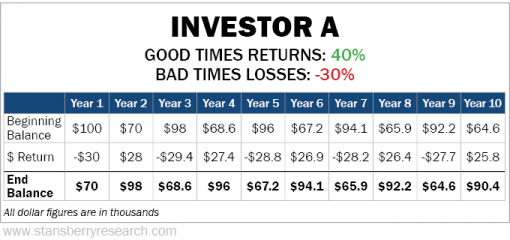Doc's note: "30% declines aren't frequent, they are inevitable."
Today my colleague and portfolio manager of Stansberry Portfolio Solutions Austin Root explains why "playing it safe" can give you a huge advantage in the market... So the next time we see stocks drop 30%, you'll be okay.
![]()
"If stocks drop 30%... is your portfolio going to be OK?"
Our founder, Porter Stansberry, posed this question to listeners on a recent episode of his Stansberry Investor Hour podcast. It's not a fun prospect to contemplate, but it's critical to think about before a drop occurs.
You must consider how your portfolio will handle a huge downdraft. And if you realize your assets aren't prepared to weather the storm, you need to adjust your holdings. Because while 30% declines aren't frequent, they are inevitable.
Today, I'll share how you can shape your personal investing goals to account for these market dips. And I'll explain why "playing it safe" can give you a huge advantage...
First... we need to consider a slight variation to the question above:
"If stocks drop 30%... are YOU going to be OK?"
This question speaks to your own personal level of risk tolerance. And how you answer should inform how you invest.
For instance, if you can stomach taking larger, short-term "paper" losses – knowing that over the long run, riskier assets do generally produce higher rates of return – then your portfolio might tilt more aggressively.
You'll invest heavily in stocks. You'll want to own some international, small-cap, and tech positions. And you'll allocate big dollars to shares of world-class companies with enduring business models and thick profit margins.
But on the other hand, if the prospect of losing a third of your net worth in a market dislocation keeps you up at night – if you value wealth preservation and steady income more than outsized capital gains – then you ought to be more conservative.
You'll own more U.S. Treasury bonds. You'll want to hold large cash and gold reserves. And you'll allocate big dollars to sturdy dividend-paying stocks and corporate bonds.
You must choose which approach or combination of assets makes sense for you. If you are not OK with a big loss, don't leave yourself in a position to take one.
However, just because you can stomach big losses doesn't mean you should, for one important reason: They're hard to recover from...
Here's a simple example to illustrate. Consider two investors: Investor A is aggressive and loves to go for the big gains. And he's pretty good at achieving them. During good years, he has earned 40% returns on his portfolio. But he's suffered some bad years when his portfolio dropped 30%.
Assuming good and bad years alternate each year and that his first year was a bad one, Investor A will end up with less money after 10 years than he had when he started... even with those strong gains. You can see his results in the chart below (using a beginning balance of $100,000).
Now consider Investor B. He invests more conservatively, making just 8% in good years. But his downside is also more muted, with 7% losses in bad years.
Using the same assumptions as we did with Investor A of alternating good and bad years and starting out with a bad one... Investor B ends up with moremoney than he started with. And he outperforms Investor A by more than 13%... even with middling positive returns.
Again, you want to avoid the big losses. As Porter said on his podcast...
Opportunity is infinite, but your capital is finite. And if you get destroyed, if you take a 30% or 40% portfolio loss, you're going to be out of the game, and you're going to miss out on all of the value that can be created next.
Since 2000, we've had two market drawdowns worse than 30%. From 2000 to 2002, the S&P 500 Index fell nearly 50%. And from 2007 to the bottom in 2009, it dropped more than 55%.
Since then, stocks have been moving up, almost without interruption. Nearly 10 years in, this is one of the longest bull markets in history, with scores of companies making new highs every week.
Bull markets do not die of old age alone... The historic length of our current run is not a reason to predict the end. But the run-up also won't last forever. And when markets correct, they usually overcorrect... fast.
Make sure you're prepared... and use smart asset allocation to keep your losses small.
Good investing,
Austin Root
Editor's note: For the latest investing insights you can use to grow and preserve your wealth, don't miss the Stansberry Investor Hour podcast. Each week, you'll hear exclusive interviews with the brightest minds in finance... Plus, Porter Stansberry and Buck Sexton dive in with candid discussion on the headlines you need to hear most. It's all available for free online... To listen to the full episode Austin discussed today, click here.


